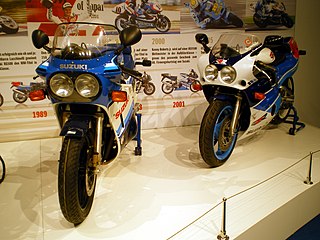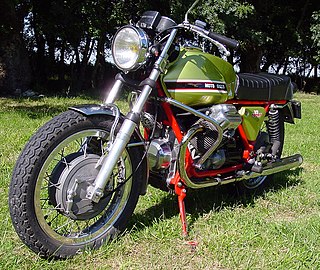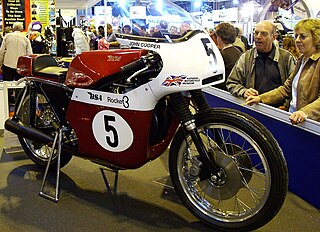
Monocoque, also called structural skin, is a structural system in which loads are supported by an object's external skin, in a manner similar to an egg shell. The word monocoque is a French term for "single shell".

A bicycle frame is the main component of a bicycle, onto which wheels and other components are fitted. The modern and most common frame design for an upright bicycle is based on the safety bicycle, and consists of two triangles: a main triangle and a paired rear triangle. This is known as the diamond frame. Frames are required to be strong, stiff and light, which they do by combining different materials and shapes.

The Suzuki GSX-R is a series of sport bikes made by Japanese manufacturer Suzuki. Current models are the GSX-R125 and GSX-R150 since 2017; GSX-R600 which was manufactured from 1992 to 1993, and then since 1997; the GSX-R750 since 1985; and the GSX-R1000 since 2001.

Stanley Michael Bailey Hailwood, was a British professional motorcycle racer and racing driver. He is regarded by many as one of the greatest racers of all time. He competed in the Grand Prix motorcycle world championships from 1958 to 1967 and in Formula One between 1963 and 1974. Hailwood was known as "Mike The Bike" because of his natural riding ability on motorcycles with a range of engine capacities.

Giacomo Agostini is an Italian multi-time world champion Grand Prix motorcycle road racer. Nicknamed Ago, he amassed 122 Grand Prix wins and 15 World Championship titles. Of these, 68 wins and 8 titles came in the 500 cc class, the rest in the 350 cc class. For these achievements obtained over the course of a career spanning 17 years, the AMA described him as "...perhaps the greatest Grand Prix rider of all time". In 2000, Agostini was inducted into the MotoGP Hall of Fame as a MotoGP Legend, while in 2010, he was named an FIM Legend for his motorcycling achievements. He considers himself a "dubious" Roman Catholic.
Keith Bontrager is a motorcycle racer who became a pioneer in the development of the modern mountain bike. Between 1980 and 1995, he was president of his own Bontrager Company, which continues to develop components for Trek Bicycle Corporation after Trek bought out Bontrager.

Lugged steel frame construction is a method of building bicycle frames using steel tubing mated with socket-like sleeves, called lugs. For most of the bicycle's history, steel has been the primary material for bicycle frames, with lugged construction the primary assembling method. Steel continues in use by builders of high-quality steel frames, though its dominance as a frame material has waned since the mid-1990s displaced largely by aluminum and carbon fiber; lugging has been displaced by TIG welding.

The Ducati 750 Imola Desmo is a racing motorcycle built by Ducati that won the 1972 Imola 200 race in the hands of Paul Smart. This win helped define Ducati's approach to racing.
Waterford Precision Cycles is a small bicycle manufacturer based in Waterford, Wisconsin. Waterford produces high-end, custom, hand-built, steel-alloy frame bicycles, particularly road, criterium, stage, track, and cyclocross racing bicycles, that range in price from about $2,500 to $8,500. Waterford builds both TIG welded and lugged steel frames to order, and specializes in custom and unique bicycle frames.

Bianchi was a brand of Italian motorcycle made from 1897 to 1967 by F.I.V. Edoardo Bianchi S.p.A.. The company also produced automobiles from 1900 to 1939, and today is a major Italian bicycle manufacturer. Edoardo Bianchi started his bicycle manufacturing business in a small shop on Milan's Via Nirone in 1885. Bianchi was a prominent name in the motorcycle racing world from 1925 to 1930.

A motorcycle frame is a motorcycle's core structure. It supports the engine, provides a location for the steering and rear suspension, and supports the rider and any passenger or luggage. Also attached to the frame are the fuel tank and battery. At the front of the frame is found the steering head tube that holds the pivoting front fork, while at the rear there is a pivot point for the swingarm suspension motion. Some motorcycles include the engine as a load-bearing stressed member; while some other bikes do not use a single frame, but instead have a front and a rear subframe attached to the engine.

The featherbed frame was a motorcycle frame invented by the McCandless brothers and offered to the British Norton motorcycle company to improve the performance of their racing motorcycles in 1950. It was considered revolutionary at the time, and the best handling frame that a racer could have. Later adopted for Norton production motorcycles, it was also widely used by builders of custom hybrids such as the Triton, becoming legendary and remaining influential to this day.
Cyfac International is a manufacturer of bicycles in La Fuye, in the Loire Valley of France. The name is an acronym that translates from French to "Handmade Bicycle Frames". "Cy" represents cycle (bicycle), "f" for fabriqué (made), "a" for "artisanal" (artisan), and the final C stands for cadres (frame). The Cyfac Postural System is a bicycle fitting system based on research at Lyon Center of Sports Medicine.

Antonio Cobas was a Spanish Grand Prix motorcycle designer, constructor and mechanic who built world championship winning motorcycles. Cobas was credited with being the originator of the modern, aluminum frame chassis now used on many modern racing and production motorcycles.
Colin Jordan Seeley was a British motorcycle retailer who later became a motorcycle sidecar racer, motorcycle designer, constructor and retailer of accessories. In 1992 he was involved in running the Norton Rotary race team.

Lino Tonti was an Italian motorcycle engineer known for designing a number of sport and racing motorcycles in the 1950s and 1960s, and for creating his signature 'Tonti frame' for Moto Guzzi's 1971 V7 Sport, setting his stamp on all Moto Guzzis since.
Stelbel is an Italian manufacturer of racing bicycles, founded in 1973 by Stelio Belletti.
Antenore Belletti was an Italian craftsman and the father of Stelio Belletti.
Arturo Magni was an Italian engineer racing team manager and entrepreneur.

The BSA/Triumph racing triples were three cylinder 750 cc racing motorcycles manufactured by BSA/Triumph and raced with factory support from 1969-1974. There were road racing, production racing, endurance racing and flat track variants. The machines were based on the road-going BSA Rocket 3/Triumph Trident.















